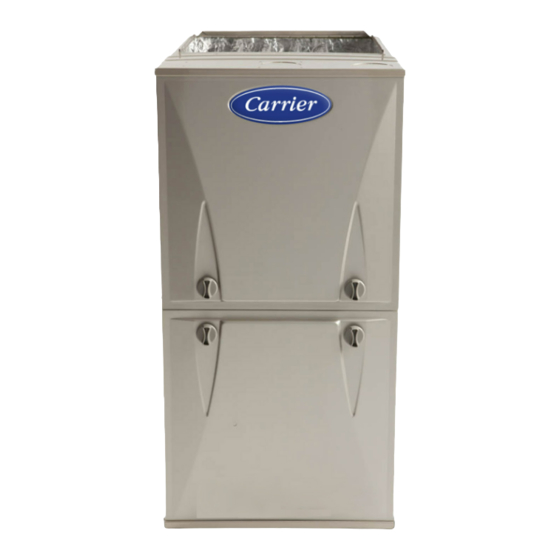Advertisement
Quick Links
Installation, Start-up, Operating and
Service and Maintenance Instructions
NOTE:
Read
the entire
instruction
manual
before
starting
the
installation.
SAFETY
CONSIDERATIONS
.........................
2
INTRODUCTION
...................................
3
CODES
AND
STANDARDS
...........................
3
ELECTROSTATIC
DISCHARGE
(ESD) PRECAUTIONS
. . . 3
ACCESSORIES
.....................................
3
LOCATION
........................................
7
General
.........................................
7
AIR FOR COMBUSTION
AND VENTILATION
..........
8
Introduction
.....................................
8
CONDENSATE
TRAP
...............................
12
Upflow
........................................
12
Downflow
.....................................
12
Horizontal
.....................................
12
CONDENSATE
DRAIN
.............................
16
INSTALLATION
...................................
19
Upflow
........................................
19
Downflow
.....................................
19
Horizontal
......................................
20
Filter Arrangement
...............................
21
AIR DUCTS
.......................................
28
General
Requirements
.............................
28
Ductwork
Acoustical
Treatment
.....................
28
GAS PIPING
......................................
30
ELECTRICAL
CONNECTIONS
.......................
31
220-V
Wiring
...................................
31
J-Box
Installation
................................
32
24-V
Wiring
....................................
32
Accessories
.....................................
32
Alternate
Power Supplies
..........................
33
VENTING
........................................
36
General
........................................
36
Materials
.......................................
36
Venting
Systems
.................................
36
Locating
the Vent Termination
......................
37
Combustion
Air and Vent Piping Insulation
Guidelines
...
39
START-UP,
ADJUSTMENT,
AND
SAFETY
CHECK
......
56
General
.........................................
56
Prime Condensate
Trap
.............................
56
Purge Gas Lines
...................................
56
Adjustments
......................................
57
SERVICE
AND MAINTENANCE
PROCEDURES
........
65
Cleaning
Heat Exchangers
...........................
70
SEQUENCE
OF OPERATION
........................
75
PARTS
REPLACEMENT
GUIDE
......................
79
TABLES
Loose Parts Bag
.....................................
4
Minimum
Clearances
to Combustible
Materials
.............
4
Minimum
Free Area Required
.........................
10
Minimum
Space Volumes
.............................
10
Filter Size Information
...............................
22
Opening
Dimensions
................................
24
Air Delivery
CFM ...................................
29
Maximum
Capacity
of Pipe
...........................
31
Electrical
Data ......................................
33
Vent Termination
Kit t\,r Direct Vent (2-Pipe)
System
.......
37
Combustion-Air
Vent Pipe, Fitting 8: Cement Material .......
42
Maximum
Allowable
Exposed
Vent Lengths
Insulation
......
43
Maximum
Equivalent
Vent Length
......................
44
Deductions
from Maximum
Equivalent
Vent Length
........
44
Blower
Off Delay Setup Switch
........................
58
Altitude
Derate Multiplier
for U.S.A .....................
60
Gas Rate
..........................................
62
Orifice Size and Manifold
Pressure
.....................
63
ISO9001
Always
Ask
For
Portions
of the text and tables are reprinted
from NFPA
54/ANSI
Z223.1-2012©,
with
permission
of
National
Fire
Protection
Association,
Quincy,
MA 02269
and American
Gas Association,
Washington
DC 20001.
This reprinted
material
is not the complete
and official
position
of the NFPA
or ANSI
on the referenced
subject,
which is represented
only by the standard
in its entirety.
Advertisement













